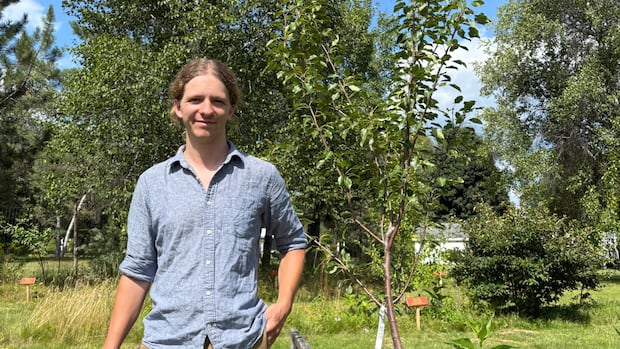New BrunswickNew Brunswick food forest tours are in full swing until September, an opportunity organizers say is about education and promoting access to food.17 food forests across New Brunswick welcome visitors, give tours this summerHope Edmond · CBC News · Posted: Aug 10, 2025 5:00 AM EDT | Last Updated: 2 hours agoAndrew Mathis, the manager of the St. Mary’s Community Food Forest in Sitansisk, says it started in 2021 as a project to address food insecurity. (Hope Edmond/CBC News )Beneath an oak tree lies a checkered blanket and a picnic basket, surrounded by a sea of fruit trees and rows of root vegetables.The St. Mary’s Community Food Forest is just behind the community’s Anglican Church in Sitansisk, also known as St. Mary’s First Nation, in the Fredericton area.People can pick organic, fresh food at any time of day — for free. Andrew Mathis, who runs the food forest at St. Mary’s, is organizing a provincewide tour of 17 such gardens, along with Sima Usvyatsov.”A food forest is a diverse planting of mostly food-bearing plants that aims to mimic a natural ecosystem,” Usvyatsov says.Mathis hopes people from across the province will visit the food forest in Sitansisk, which is just one stop on the New Brunswick Food Forest Tour. “It’s really a food security project,” he said. “Not everyone has a front lawn to grow food on, so these community spaces that don’t have individual plots really make it very accessible.” At St. Mary’s Food Forest, Mathis said, you don’t have to plant something to be able to harvest. He said members of the community are welcome to grow their own food as long as they don’t mind sharing.Mathis picks a fresh carrot grown in the St. Mary’s Community Food Forest. (Hope Edmond/CBC News)Growing in the food forest this season is a variety of fruit, including apples, kiwi, peaches, pears, cherries and berries. Vegetables like squash, carrots and string beans can also be seen growing in the garden beds. The food forest even has a heartnut tree, a walnut native to Japan, and is growing bamboo and willow as well. “It’s really open to whatever you want it to be,” Mathis said of the food forest. “Maybe somebody focuses on medicine … another person focuses on medicine and mushrooms. Somebody else wants to grow mostly chestnuts.”Food forests growing in popularityFarther south, on the Kingston Peninsula, Usvyatsov operates Sima’s Roots & Fruits, a food forest that sells plants and hosts gardening workshops.Usvyatsov said there has been more awareness about food forests in recent years.”We’re seeing more people planting stuff in their own yards, but we’re also seeing municipalities plant and run food forests,” she said.In June, 30 fruit trees were planted in Fredericton’s Wilmot Park as part of a municipal project. The food forest tours will continue until September. Usvyatsov said about 150 people are registered.”I’m very big on community building,” Usvyatsov said. “Seeing people learn from each other … is such a tremendous thing.”Mathis said the tours are a learning opportunity but are also about access to food. According to Mathis, each food forest is different, growing a variety of foods. (Hope Edmond/CBC News)”It’s a really great way to provide some food security to individual households but also to experiment and have fun and see what we can grow here.” Mathis said. The St. Mary’s Community Food Forest is also building a pizza oven, expected to be completed in September.”We wanted to have something that would be able to draw people into this space and use it more consistently than just when certain things are in season,” Mathis said.ABOUT THE AUTHORHope Edmond is working with the Fredericton bureau at CBC. You can send her story tips to hope.edmond@cbc.ca.
Food forests offer way to address food insecurity and also have fun











